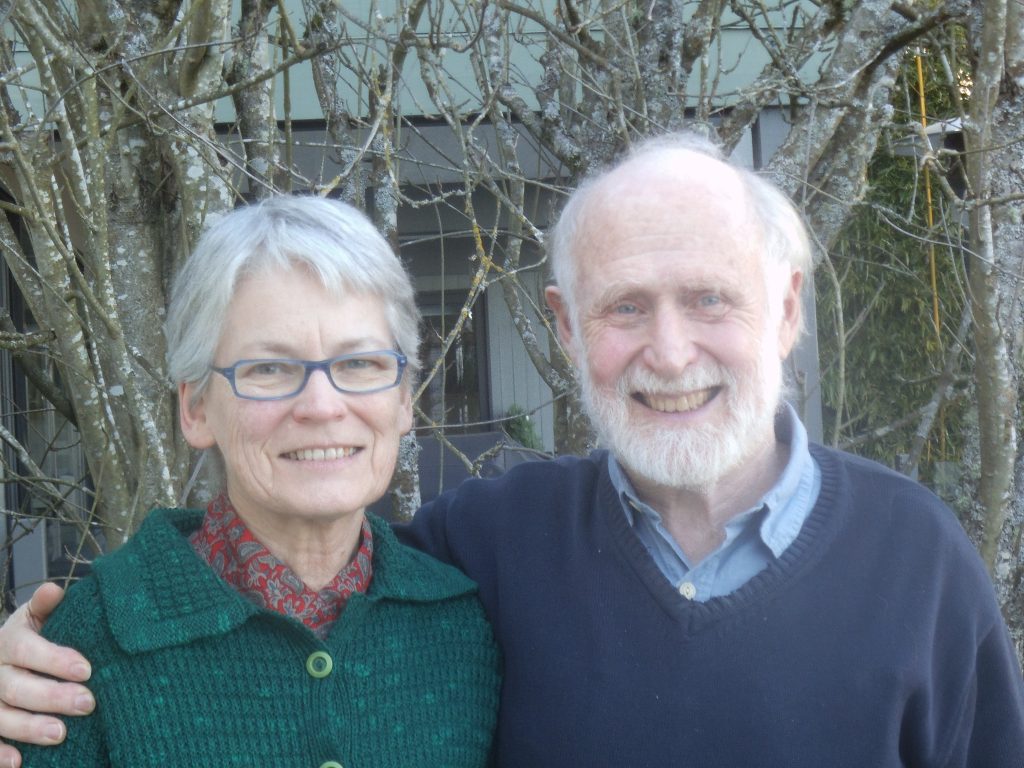Why aren’t mental health services more responsive to those in crisis?
MHSF, with a legacy of work on the front lines,
knows from gritty experience what needs to be done and
has a focused strategy for helping to make it happen.
Marguerite Hardin: Family-Support Pioneer

It began when her son Kelsey, a bright and outgoing kid, began having difficulty, with irrational outbursts, anger directed at his sister, and then a drop-off in school work. He was only 13 years old. Later on this would be seen to be the beginning of “insidious onset” of schizophrenia. It also became clear, later, that the illness had been triggered by Kelsey’s smoking pot. In the meantime, though, Marguerite and her husband Herschel had no idea what was happening and no idea what to do, despite consulting child psychiatrists, despite also relocating him to a home for troubled youth, and despite a stay at the Burnaby Mental Hospital, since closed, at Canada Way and Willingdon.
It wasn’t until he was 18 that he was finally diagnosed. By that time he was floridly psychotic. Given wild hitchhiking adventures in the U.S., with a disorganized mind, including literally sleeping under bridges, it was a wonder he was still alive. A history of major mental illness began: severe and prolonged psychotic breaks, a couple of suicide attempts, elaborate delusional systems, hallucinations (visual as well as auditory)….in and out of psychiatric wards, including long stays at the old Riverview Hospital, until the illness, together with the help of a new anti-psychotic, clozapine, relented a bit….a classic case of schizophrenia.

When it came to helping the mentally ill and their families, she was a force of nature. As NSSS’s long-time president (1993-2002, 2003-2009), she built the society into a model organization. In 1995, she established its ground-breaking Family Support Centre, a full-time “place of our own” for family members, dealing not just with schizophrenia but also with other serious mental illness – bipolar disorder, major depression, other mood disorders. She went on from there to provide one-on-one peer family support and crisis counselling for family members trying to help their ill relative, a unique peer-support model which she herself created in the doing.
A key part of that support role was helping family members negotiate “the system” – mental health services – and to get timely treatment for someone falling into the depths of psychosis, often in the face of health services’ passiveness and lack of understanding. This was front-line work, sometimes in a race against possible suicide. It also meant advocacy – pushing or finessing the system to act and, at the same time, tackling issues that lay behind system failures, failures that often resulted in tragedy.

Advocacy was in fact where Marguerite had begun her involvement, when her son was first diagnosed. It started with committee work, followed by the writing of a “manifesto” explaining that serious mental illness was a biological disease of the brain and that treatment, including involuntary admission where appropriate, was therefore necessary. No such clear and concise explanation had been available – nothing that described the reality of the illness as it was – so she sat down and wrote one herself. Serious mental illness wasn’t feeling blue, being maladjusted, or having been badly brought up by one’s mother (an old shibboleth), that one could work one’s way through with “talk therapy” or could prevent by healthy living. Such illness (schizophrenia, mood disorders like bipolar) was illness, and illness required treatment.

Family members, though, seeing their loved one struggling with psychosis, did understand. Marguerite spoke for them and went to work for them, sharing her knowledge and experience (and tricks of the trade), letting them know they weren’t alone, getting on the phone, interacting with the police in emergency situations, going to Emergency at Lions Gate Hospital herself in cases, and also attending court with family members and speaking to lawyers when the ill person became tangled up in the justice system.
She saw crises and difficulties on the ground the way that family members and the mentally ill see them. She also knew the ropes. She benefitted, uniquely so as it happened, in the scale of her work: hundreds and hundreds of crisis cases over the course of 25 plus years. She was informed, as well, by her own personal experience, years earlier, helping and trying to safeguard her son through the long acute phase of his illness, and continuing to support him through his ongoing struggle with the long-term residual symptoms of the illness, including in his case severe anxiety.
The end result: an incisive understanding of what needs to be done to improve the lives of the seriously mentally ill.
Marguerite’s Husband, Herschel, Also Became Involved
Marguerite’s husband, Herschel, a writer and freelance broadcaster, also became involved, first with some policy documents in the 1990s and then working actively in tandem with Marguerite in key areas.
His participation in the North Shore Schizophrenia Society ultimately covered a wide range of activities, from president and fundraiser to handyman at the Family Support Centre and Santa Claus at the society’s annual Christmas banquet. His most important contributions, however, were in education and advocacy.
He rescued the society’s flagship education course Family-to-Family when it was foundering, first by stepping in as lead teacher when nobody else could be found, and then seeing to the training of teacher instructors, to train others, so there would be a stable of teachers available into the future. He himself taught the course many times.
The course comes from the National Alliance on Mental Illness in the U.S. Mindful of the advocacy priorities of family members here in B.C., as different from the American scene, and also the different legislation here, he rewrote a couple of applicable sections in the course, including the class on advocacy. This covered, among other things, the provision for involuntary admission in B.C. and the legislation governing the sharing of clinical information with family members – crucial matters for family members trying to help their loved ones.
In 2008, hearing story after story from Marguerite of system failures, he decided, in order to help facilitate change, it would be a good idea to share those stories with others. He created the NSSS Advocacy Bulletin for the purpose, an often gripping and hard-edged journalistic reporting of such cases and of related policy issues and other matters. The Bulletin, drawing on Marguerite’s unique front-line knowledge of what actually happens and benefitting by the society’s independence from health authority funding, portrayed a reality that even service providers wouldn’t be aware of, caught up in their own health-authority world and without the direct and untrammeled access to families’ experiences that Marguerite enjoyed. The Bulletin’s archive, the ones Herschel wrote – 34 issues through to September 2015 – represents a unique resource base for understanding the issues at play and for continuing advocacy.
In his capacity as NSSS president, and later as advocacy coordinator, he also took up individual advocacy cases, most notably getting Vancouver Coastal Health to accept responsibility for the suicide of a Vancouver man whose sister had tried 16 different times to get help for him (the Marek Kwapiszewski case). Vancouver Coastal, as a result, organized workshops for staff on the Mental Health Act.
To enable Marguerite’s knowledge base and experience to be passed on to a new generation of support workers, Herschel conceived, and was instrumental in the development of, a manual and training program for one-on-one family peer crisis support. This program has yet to be fully implemented.
Maybe the single most important advocacy initiative Herschel undertook, however, was an op-ed piece, just 1,100 words, that he wrote for the Vancouver Sun in 1993, Uncivil Liberties. The article made the case for involuntary admission, not just in terms of a father of someone with schizophrenia but in his capacity as a life-long civil libertarian. He pointed out that someone with schizophrenia, but without insight into their illness, was a prisoner of their illness unless they could be treated, and since they lacked insight, only involuntary admission could provide for that – could free them from the “Bastille of their psychosis,” as he put it. Otherwise the ravages of the illness and worse, like suicide, destroyed the person.
The article was picked up both in Canada and the United States and has had what journalists call “long legs,” being used in pro-treatment advocacy campaigns in the U.S., particularly in California and New York State, and continuing to be cited more than 25 years after it first appeared. It also led to a personal connection between Herschel and Marguerite, here in Greater Vancouver, and two major advocacy organizations in the U.S., the Treatment Advocacy Center and mentalillnesspolicy.org.

The Legacy Distilled
Asked what she thought would be the core of her legacy, Marguerite mentioned two things. The first was the value and reward of working with family members, with their profound experience of what people go through when someone in their family falls ill with a severe mental illness, and what the ill person goes through. Involved family members are also key players in both diagnosis and rehabilitation of their ill relative. They’ll often pick up signs of deterioration and relapse long before the indications are noticed or given any weight by case workers or psychiatrists.
Family members don’t just need to be listened to. They need to be included as an integral part of the treatment team. Because, too, they don’t have the resources (salaries for their time, etc.) and organizational power of mental health services, it’s doubly important that advocacy and resources be made available to them by peer organizations such as the Foundation.
The second core element is the need to focus on the reality of what serious mental illness is – a biological illness of the brain – and consequently focus in turn on what needs to be done and not let the understanding of the severity of such illness be obscured or watered down. Such illnesses are tough, and schizophrenia is the most disabling of them all, not just in its acute phase but also in its ongoing post-discharge phase, with its continuing, often life-long residual symptoms (see “Negative symptoms” in our Issues section), often continuing lack of insight and refractory delusions, vulnerability to relapse, and metabolic syndrome.
Our corresponding duty is to advocate for the mentally ill when that understanding by mental health services is lacking, and to continue advocating as need be, even in the face of discouragement. We owe it to the seriously mentally ill to do so.